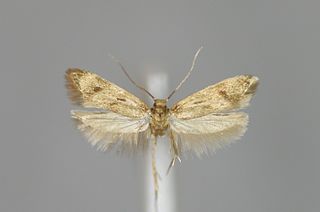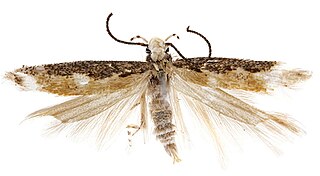
The veery is a small North American thrush species, a member of a group of closely related and similar species in the genus Catharus, also including the gray-cheeked thrush, Bicknell's thrush, Swainson's thrush, and hermit thrush. Alternate names for this species include Wilson's thrush and tawny thrush. Up to six subspecies exist, which are grouped into the eastern veery, the western veery or willow thrush, and the Newfoundland veery.

The black-faced cormorant, also known as the black-faced shag, is a medium-sized member of the cormorant family. Upperparts, including facial skin and bill, are black, with white underparts. It is endemic to coastal regions of southern Australia.

Anarsia is a genus of moths in the family Gelechiidae.

Aroga is a genus of moths in the family Gelechiidae.

Athrips is a genus of moths in the family Gelechiidae.

Bryotropha is a genus of the twirler moth family (Gelechiidae). Among these, it is placed in the tribe Anomologini of subfamily Gelechiinae; the tribe was formerly considered a distinct subfamily Anomologinae.
Ephysteris is a genus of the twirler moth family (Gelechiidae). Among these, it is assigned to tribe Gnorimoschemini of the subfamily Gelechiinae. Even though it is a rather diverse and widespread group, most of these small and inconspicuous moths were overlooked by scientists until the early 20th century. Almost 90 species are known today but new ones are still being discovered.

Megacraspedus is a genus of moths in the family Gelechiidae, found primarily in the Palearctic.

Monochroa is a genus of moths in the family Gelechiidae.

Neofriseria is a genus of moths in the family Gelechiidae.

Scrobipalpa is a genus of moths in the family Gelechiidae. Euscrobipalpa has sometimes been treated as a distinct subgenus, or even as a full genus, but is generally no longer recognised as valid, following Ponomarenko & Park (2007).

Chrysaora fuscescens, the Pacific sea nettle or West Coast sea nettle, is a widespread planktonic scyphozoan cnidarian—or medusa, "jellyfish" or "jelly"—that lives in the northeastern Pacific Ocean, in temperate to cooler waters off of British Columbia and the West Coast of the United States, ranging south to México. The Pacific sea nettle earned its common name in-reference to its defensive, 'nettle'-like sting; much like the stinging nettle plant, the sea nettle's defensive sting is often irritating to humans, though rarely dangerous.

Borkhausenia fuscescens is a moth of the family Oecophoridae. It is found in Europe.
Spiniphallellus is a genus of moths in the family Gelechiidae.

Gelechiinae is a subfamily of moths in the family Gelechiidae. It was described by Henry Tibbats Stainton in 1854.

Anomologinae is a subfamily of moths in the family Gelechiidae.
Scrobipalpa halimioniella is a moth in the family Gelechiidae. It was described by Peter Huemer and Ole Karsholt in 2010. It is found southern France and has also been recorded from Ukraine.
Scrobipalpa oleksiyella is a moth in the family Gelechiidae. It was described by Peter Huemer and Ole Karsholt in 2010. It is found in the southern Ural Mountains.
Spiniphallellus stonisi is a moth of the family Gelechiidae. It was described by Oleksiy V. Bidzilya and Ole Karsholt in 2008. It is found in south-eastern Kazakhstan.
Spiniductellus is a genus of moths in the family Gelechiidae.











